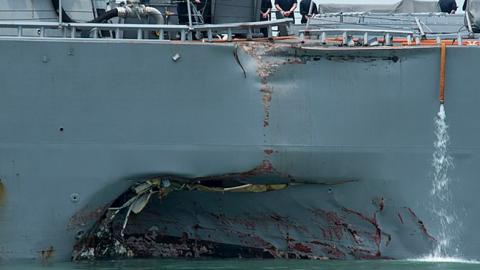Coming on the heels of the June collision involving the USS Fitzgerald (DDG 62) in which seven Sailors were killed, news of Monday's collision between USS John S. McCain (DDG 56) and the Alnic MC—a 30,000-ton Libyan flagged oil and chemical tanker—naturally raises questions about U.S. Navy operations and the standards of seamanship and navigation practiced in the fleet. None of these questions can be easily answered, but all can aid in forming reasonable hypotheses for further inquiry as the Navy attempts to understand the two tragedies. Nothing here is designed to affix blame or responsibility. We cannot know how the USS McCain and Alnic MC collided, and we do not yet have the results of the Navy’s exhaustive inquiry into the earlier USS Fitzgerald collision. However, ships adhering to the maritime rules of the road do not collide, and in each of these situations, some level of human error will assuredly be determined. There are few organizations like the U.S. Navy in which a culture of responsibility and accountability is so consistently maintained, and any systemic review of these collisions will surely encompass questions far deeper than these.
- Are U.S. Navy seamanship and navigation practices and skills up to the challenge of operations in increasingly busy waters? The Chief of Naval Operations Admiral John Richardson is fond of stating in his public speeches that during his time in the Navy (since 1982), commercial shipping density has increased 400%. Due to the nature of its operations, the U.S. Navy tends to operate extensively proximate to the highest traffic densities in this already dense environment. It is reasonable to inquire as to whether the proficiency of those assigned to safely navigate U.S. Navy ships is sufficient to meet the demands of this more demanding (than in the past) environment.
- Does the tempo of operations in the Western Pacific and the demand that it places on forces allocated there create situations in which ships sacrifice unit level basic training time to meet high priority operational requirements? Put another way, are there too few ships for too many requirements? The fleet in the Western Pacific is extraordinarily busy, with bilateral and multinational exercises, high-visibility port visits, Freedom of Navigation (FON) operations, and ballistic missile defense operations just some of the demands. Ships home-ported there have an extremely high operational tempo, and with periods of inactivity necessary to perform both preventative and emergent maintenance, time available for “inside the lifelines” training is squeezed. These “forward deployed naval forces” (FDNF), already operate on a much tighter cyclical timeline when compared to ships based in the United States and Hawaii, and if that timeline has been even more compressed, basic skills and readiness may be impacted.
- Is the Navy making the best use of available technology to aid its watch-standers in making good decisions? Do the various sensors and systems resident in the Navy’s sophisticated warships (radars, sonars, electronics support measures) work to the best advantage of the people operating them? A modern warship is a marvel of engineering, but to a large extent, it remains a kluge of systems that allow it to fight, move, communicate, and contain damage. A staggering amount of data fusion goes on the brains of young men and women standing watch on the bridge or in the ship’s operations room, rather than in some kind of central processing computer. It seems straightforward to assume that data be could better fused and then processed by decision-making algorithms to present watch-standers with decision quality information. This is not artificial intelligence; it is simply more elegant systems engineering. The plain truth, however, is that the Navy acquisition system does not currently have the ability to do this perform this level of systems engineering, and even if it did, several different program offices across widely disparate organizations would have to closely cooperate to acquire it.
I have every confidence that the Navy will move out quickly in trying to determine the extent of systemic links between the USS Fitzgerald and the USS John S. McCain collisions. No stone will be left unturned, and the organization will emerge more sharply focused on the unrelenting demands of the sea.















